Formylation as a Chemical Tool to Modulate the Performance of Photosensitizers Based on Boron Dipyrromethene Dimers
Abstract
1. Introduction
2. Results and Discussion
3. Materials and Methods
3.1. Spectroscopic Techniques
3.2. Quantum Mechanics Calculations
4. Conclusions
Supplementary Materials
Author Contributions
Funding
Institutional Review Board Statement
Informed Consent Statement
Data Availability Statement
Acknowledgments
Conflicts of Interest
References
- Ferreira dos Santos, A.; Quieroz de Almeida, D.R.; Ferreira Terra, L.; Baptista, M.S.; Labriola, L. Photodynamic therapy in cancer treatment—An update review. J. Cancer Metastasis Treat. 2019, 5, 25. [Google Scholar]
- Li, X.; Kolemen, S.; Yoon, J.; Akkaya, E.U. Activatable photosensitizers: Agents for selective photodynamic therapy. Adv. Funct. Mater. 2017, 27, 1604053. [Google Scholar] [CrossRef]
- Huang, L.; Han, G. Near infrared boron dipyrromethene nanoparticles for optotheragnostics. Small Methods 2018, 2, 1700370. [Google Scholar] [CrossRef] [PubMed]
- Li, X.; Lee, S.; Yoon, J. Supramolecular photosensitizers rejuvenate photodynamic therapy. Chem. Soc. Rev. 2018, 47, 1174–1188. [Google Scholar] [CrossRef] [PubMed]
- Li, X.; Lovell, J.F.; Yoon, J.; Chen, X. Clinical development and potential of photothermal and photodynamic therapies for cancer. Nat. Rev. Clin. Oncol. 2020, 17, 657–674. [Google Scholar] [CrossRef]
- Gunaydin, G.; Gedik, M.E.; Ayan, S. Photodynamic therapy-current limitations and novel approaches. Front. Chem. 2021, 9, 691697. [Google Scholar] [CrossRef]
- Pham, T.C.; Nguyen, V.-N.; Choi, Y.; Lee, S.; Yoon, J. Recent strategies to develop innovative photosensitizers for enhanced photodynamic therapy. Chem. Rev. 2021, 121, 13454–13619. [Google Scholar] [CrossRef]
- Zhao, X.; Liu, J.; Fan, J.; Chao, H.; Peng, X. Recent progress in photosensitizers for overcoming the challenges of photodynamic therapy: From molecular design to application. Chem. Soc. Rev. 2021, 50, 4185–4219. [Google Scholar] [CrossRef]
- Yano, S.; Hirohara, S.; Obata, M.; Hagiya, Y.; Ogura, S.-I.; Ikeda, A.; Kataoka, H.; Tanaka, M.; Joh, T. Current states and future views in photodynamic therapy. J. Photochem. Photobiol. C 2011, 12, 46–67. [Google Scholar] [CrossRef]
- Zhao, J.; Wu, W.; Sun, F.; Guo, S. Triplet photosensitizers: From molecular design to applications. Chem. Soc. Rev. 2013, 42, 5323–5351. [Google Scholar] [CrossRef]
- Sai, D.L.; Lee, J.; Nguyen, D.L.; Kim, Y.-P. Tailoring photosensitive ROS for advanced photodynamic therapy. Exp. Mol. Med. 2021, 53, 495–504. [Google Scholar] [CrossRef]
- Lakshmi, V.; Rao, M.R.; Ravikanth, M. Halogenated boron-dipyrromethenes: Synthesis, properties and applications. Org. Biomol. Chem. 2015, 13, 2501–2517. [Google Scholar] [CrossRef] [PubMed]
- Nguyen, V.-N.; Yan, Y.; Zhao, J.; Yoon, J. Heavy-atom-free photosensitizers: From molecular design to applications in the photodynamic therapy of cancer. Acc. Chem. Res. 2021, 54, 207–220. [Google Scholar] [CrossRef] [PubMed]
- Zhao, Y.; Duan, R.; Zhao, J.; Li, C. Spin-orbit charge transfer intersystem crossing in perylenemonoimide-phenothiazine compact electron donor-acceptor dyads. Chem. Commun. 2018, 54, 12329–13332. [Google Scholar] [CrossRef] [PubMed]
- Kandrashkin, Y.E.; Zhang, X.; Sukhanov, A.A.; Hou, Y.; Wang, Z.; Liu, Y.; Voronkova, V.K.; Zhao, J. TREPR study of the anisotropic spin-lattice relaxation induced by intramolecular energy transfer in orthogonal BODIPY dimers. J. Phys. Chem. C 2020, 124, 3939–3951. [Google Scholar] [CrossRef]
- Lv, M.; Wang, X.; Wang, D.; Li, X.; Liu, Y.; Pan, H.; Zhang, S.; Xu, J.; Chen, J. Unravelling the role of charge transfer state during ultrafast intersystem crossing in compact organic chromophores. Phys. Chem. Chem. Phys. 2021, 23, 25455–25466. [Google Scholar] [CrossRef]
- Peterson, E.J.; Rawson, J.; Beratan, D.N.; Zhang, P.; Therien, M.J. Regulating singlet-triplet energy gaps through substituent-driven modulation of exchange and coulomb interactions. J. Am. Chem. Soc. 2022, 144, 15457–15461. [Google Scholar] [CrossRef]
- Hu, W.; Zhang, X.-F.; Liu, M. Thioesterification inducing efficient excited triplet state and singlet oxygen generation: Heavy-atom-free BODIPY photosensitizer based on the S1(n-π*) state. J. Phys. Chem. C 2021, 125, 5233–5242. [Google Scholar] [CrossRef]
- Dong, Y.; Dick, B.; Zhao, J. Twisted Bodipy derivative as a heavy-atom-free triplet photosensitizer showing strong absorption of yellow light, intersystem crossing, and a high-energy long-lived triplet state. Org. Lett. 2020, 22, 5335–5339. [Google Scholar] [CrossRef]
- Yan, Y.; Sukhanov, A.A.; Bousquet, M.H.E.; Guan, Q.; Zhao, J.; Voronkova, V.K.; Escudero, D.; Barbon, A.; Xing, Y.; Gurzadyan, G.G.; et al. Does twisted π-conjugation framework always induce efficient intersystem crossing? A case study with benzo[b]- and [a]phenanthrene-fused BODIPY derivatives and identification of a dark state. J. Phys. Chem. B 2021, 125, 6280–6295. [Google Scholar] [CrossRef]
- Mayländer, M.; Nolden, O.; Franz, M.; Chen, S.; Bancroft, L.; Qiu, Y.; Wasielewski, M.R.; Gilch, P.; Richert, S. Accessing the triplet state of perylenediimide by radical-enhanced intersystem crossing. Chem. Sci. 2022, 13, 6732–6743. [Google Scholar] [CrossRef] [PubMed]
- Zhao, J.; Chen, K.; Hou, Y.; Che, Y.; Liu, L.; Jia, D. Recent progress in heavy-atom-free organic compounds showing unexpected intersystem crossing (ISC) ability. Org. Biomol. Chem. 2018, 16, 3692–3701. [Google Scholar] [CrossRef] [PubMed]
- Filatov, M.A. Heavy-atom-free BODIPY photosensitizers with intersystem crossing mediated by intramolecular photoinduced electron transfer. Org. Biomol. Chem. 2020, 18, 10–27. [Google Scholar] [CrossRef]
- Zhang, X.; Wang, Z.; Hou, Y.; Yan, Y.; Zhao, J.; Dick, B. Recent development of heavy-atom-free triplet photosensitizers: Molecular design, photophysics and application. J. Mater. Chem. C 2021, 9, 11944–11973. [Google Scholar] [CrossRef]
- Sarbadhikary, P.; George, B.P.; Abrahamse, H. Recent advances in photosensitizers as multifunctional theranostic agents for imaging-guided photodynamic therapy of cancer. Theranostics 2021, 11, 9054–9088. [Google Scholar] [CrossRef]
- Wang, D.; Wang, X.; Zhou, S.; Gu, P.; Zhu, X.; Wang, C.; Zhang, Q. Evolution of BODIPY as triplet photosensitizers from homogeneous to heterogeneous: The strategies of functionalization to various forms and the recent applications. Coord. Chem. Rev. 2023, 482, 215074. [Google Scholar] [CrossRef]
- Liu, K.; Liu, B. Enhancing the theranostic performance of organic photosensitizers with aggregated-induced emission. Acc. Mater. Res. 2022, 3, 721–734. [Google Scholar]
- An, J.; Tang, S.; Hong, G.; Chen, W.; Chen, M.; Song, J.; Li, Z.; Peng, X.; Song, F.; Zheng, W.-H. An unexpected strategy to alleviate hypoxia limitation of photodynamic therapy by biotinylation of photosensitizers. Nat. Commun. 2022, 13, 2225. [Google Scholar] [CrossRef]
- Tabero, A.; García-Garrido, F.; Prieto-Castañeda, A.; Palao, E.; Agarrabeitia, A.R.; García-Moreno, I.; Villanueva, A.; de la Moya, S.; Ortiz, M.J. BODIPYs revealing lipid droplets as valuable targets for photodynamic theragnosis. Chem. Comm. 2020, 56, 940–943. [Google Scholar] [CrossRef]
- Mao, Z.; Kim, J.H.; Lee, J.; Xiong, H.; Zhang, F.; Kim, J.S. Engineering of BODIPY-based theranostics for cancer therapy. Coord. Chem. Rev. 2023, 476, 214908. [Google Scholar] [CrossRef]
- Cheng, H.-B.; Cao, X.; Zhang, S.; Zhang, K.; Cheng, Y.; Wang, J.; Zhao, J.; Zhou, L.; Liang, X.-J.; Yoon, J. BODIPY as multifunctional theranostic reagent in biomedicine: Self-assembly, properties and applications. Adv. Mater. 2023, 35, 2207546. [Google Scholar] [CrossRef]
- Bumagina, N.A.; Antina, E.V.; Ksenofontov, A.A.; Antina, L.A.; Kalyagin, A.A.; Berezin, M.B. Basic structural modifications for improving the practical properties of BODIPY. Coord. Chem. Rev. 2022, 469, 214684. [Google Scholar] [CrossRef]
- Boens, N.; Verbelen, B.; Ortiz, M.J.; Jiao, L.; Dehaen, W. Synthesis of BODIPY dyes through postfunctionalization of the boron dipyrromthene core. Coord. Chem. Rev. 2019, 399, 213024. [Google Scholar] [CrossRef]
- Avellanal-Zaballa, E.; Gartzia-Rivero, L.; Arbeloa, T.; Bañuelos, J. Fundamental photophysical concepts and key structural factors for the design of BODIPY-based tunable lasers. Int. Rev. Phys. Chem. 2022, 41, 177–203. [Google Scholar] [CrossRef]
- Chen, K.; Dong, Y.; Zhao, X.; Imran, M.; Tang, G.; Zhao, J.; Liu, Q. Bodipy derivatives as triplet photosensitizers and the related intersystem crossing mechanism. Front. Chem. 2019, 7, 621. [Google Scholar] [CrossRef]
- Liu, Y.; Zhou, Z.; Hou, J.; Xiong, W.; Kim, H.; Chen, J.; Zheng, C.; Jiang, X.; Yoon, J.; Shen, J. Tumor selective metabolic reporgramming as a prospective PD-L1 depression strategy to reactivate immunotherapy. Adv. Mater. 2022, 34, 2206121. [Google Scholar] [CrossRef]
- Zhou, Z.; Chen, J.; Liu, Y.; Zheng, C.; Luo, W.; Chen, L.; Zhou, S.; Li, Z.; Shen, J. Cascade two-stage tumor re-oxygenation and immune re-sensitization mediated by self-assembled albumin-sorafenib nanoparticles for enhanced photodynamic immunotherapy. Acta Pharm. Sin. B 2022, 12, 4204–4223. [Google Scholar] [CrossRef]
- Kang, Z.; Lv, F.; Wu, Q.; Li, H.; Li, Z.; Wu, F.-X.; Wang, Z.; Jiao, L.; Hao, E. Palladium(II)-catalyzed dehydrogenative strategy for direct and regioselective oligomerization of BODIPY dyes. Org. Lett. 2021, 23, 7986–7991. [Google Scholar] [CrossRef]
- Teng, K.-X.; Chen, W.-K.; Niu, L.-Y.; Fang, W.-H.; Cui, G.; Yang, Q.-Z. BODIPY-based photodynamic agents for exclusively generating superoxide radical over singlet oxygen. Angew. Chem. Int. Ed. 2021, 60, 19912–19920. [Google Scholar] [CrossRef]
- Liu, Y.; Zhao, J.; Iagatti, A.; Bussotti, L.; Foggi, P.; Castelluci, E.; Di Donato, M.; Han, K.-L. A revisit to the orthogonal bodipy dimers: Experimental evidence for the symmetry breaking charge transfer-induced intersystem crossing. J. Phys. Chem. C 2018, 122, 2502–2511. [Google Scholar] [CrossRef]
- Xue, L.; Song, X.; Feng, Y.; Cheng, S.; Lu, G.; Bu, Y. General dual-switched dynamic singlet fission channels in solvents governed jointly by chromophore structural dynamics and solvent impact: Singlet prefission energetic analyses. J. Am. Chem. Soc. 2020, 142, 17469–17479. [Google Scholar] [CrossRef]
- García-Moreno, I.; Postils, V.; Rebollar, E.; Ortiz, M.J.; Agarrabeitia, A.R.; Casanova, D. Generation of mutiple triplet states in an orthogonal bodipy dimer: A breakthrough spectroscopic and theoretical approach. Phys. Chem. Chem. Phys. 2022, 24, 5929–5938. [Google Scholar] [CrossRef]
- Zhou, Y.; Ni, W.; Ma, L.; Sun, L.; Zhao, J.; Gurzadyan, G.G. Singlet fission from upper excited states of bodipy crystalline film and single crystal. J. Phys. Chem. C 2022, 126, 17212–17222. [Google Scholar] [CrossRef]
- Prieto-Castañeda, A.; García-Garrido, F.; Díaz-Norambuena, C.; Escriche-Navarro, B.; García-Fernández, A.; Bañuelos, J.; Rebollar, E.; García-Moreno, I.; Martínez-Máñez, R.; de la Moya, S.; et al. Development of geometry-controlled all-orthogonal BODIPY trimers for photodynamic therapy and phototheragnosis. Org. Lett. 2022, 24, 3636–3641. [Google Scholar]
- Epelde-Elezcano, N.; Palao, E.; Manzano, H.; Prieto-Castañeda, A.; Agarrabeitia, A.R.; Tabero, A.; Villanueva, A.; de la Moya, S.; López-Arbeloa, I.; Martínez-Martínez, V.; et al. Rational design of advanced photosensitizers based on orthogonal BODIPY dimers to finely modulate singlet oxygen generation. Chem. Eur. J. 2017, 23, 4837–4848. [Google Scholar] [CrossRef]
- Zou, J.; Yin, Z.; Ding, K.; Tang, Q.; Li, J.; Si, W.; Shao, J.; Zhang, Q.; Huang, W.; Dong, X. BODIPY derivatives for photodynamic therapy: Influence of configuration versus heavy atom effect. ACS Appl. Mater. Interfaces 2017, 9, 32475–32481. [Google Scholar] [CrossRef]
- Zhang, X.-F.; Yang, X.; Xu, B. PET-based bisBODIPY photosensitizers for highly efficient excited triplet state and singlet oxygen generation: Tuning photosensitizing ability by dihedral angles. Phys. Chem. Chem. Phys. 2017, 19, 24792–24804. [Google Scholar] [CrossRef]
- Kandrashkin, Y.E.; Wang, Z.; Sukhanov, A.A.; Hou, Y.; Zhang, X.; Liu, Y.; Voronkova, V.K.; Zhao, J. Balance between triplet states in photoexcited orthogonal BODIPY dimers. J. Phys. Chem. Lett. 2019, 10, 4157–4163. [Google Scholar] [CrossRef]
- Prieto-Montero, R.; Sola-Llano, R.; Montero, R.; Longarte, A.; Arbeloa, T.; López-Arbeloa, I.; Martínez-Martínez, V.; Lacombe, S. Methylthio BODIPY as a standard triplet photosensitizer for singlet oxygen production: A photophysical study. Phys. Chem. Chem. Phys. 2019, 21, 20403–20414. [Google Scholar]
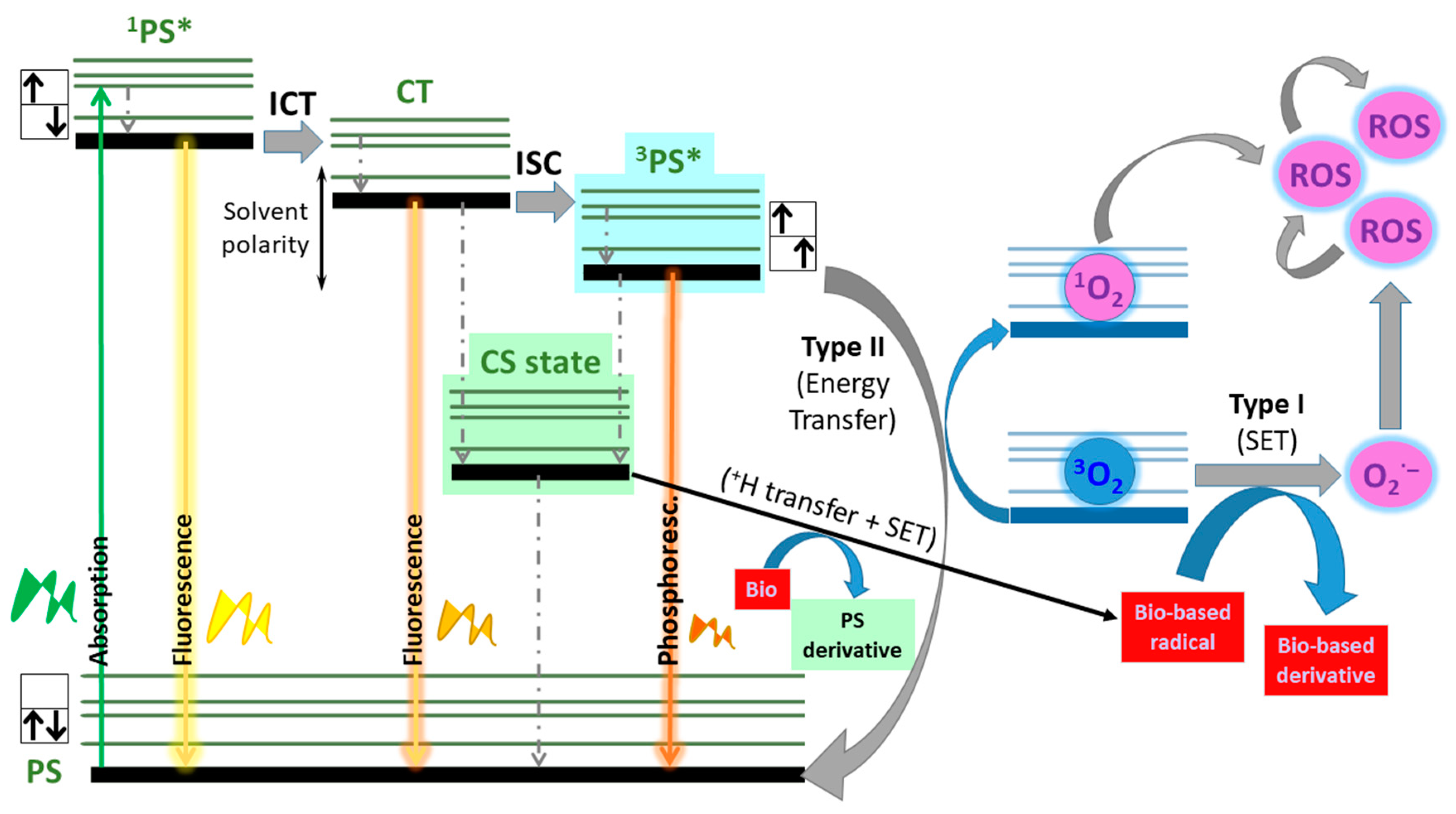
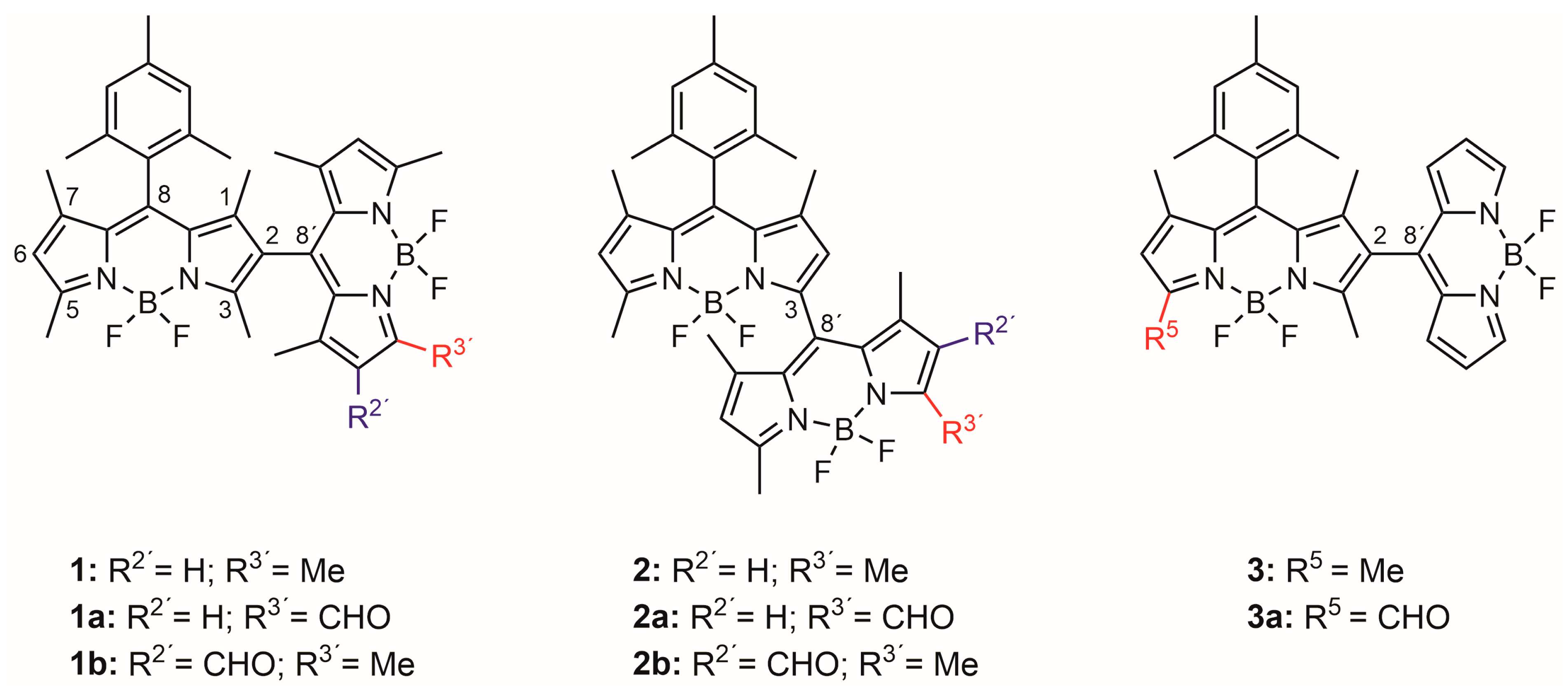

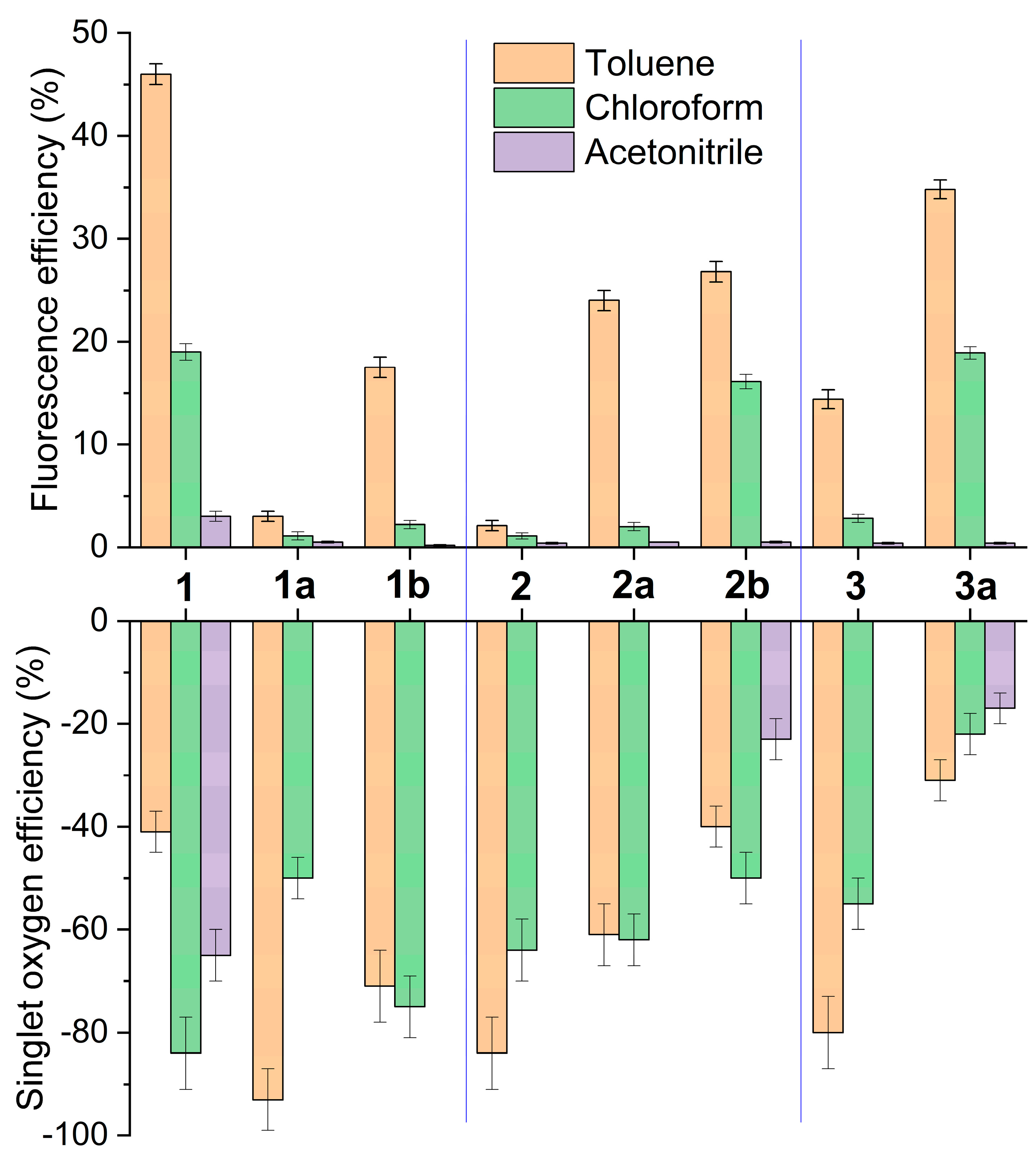
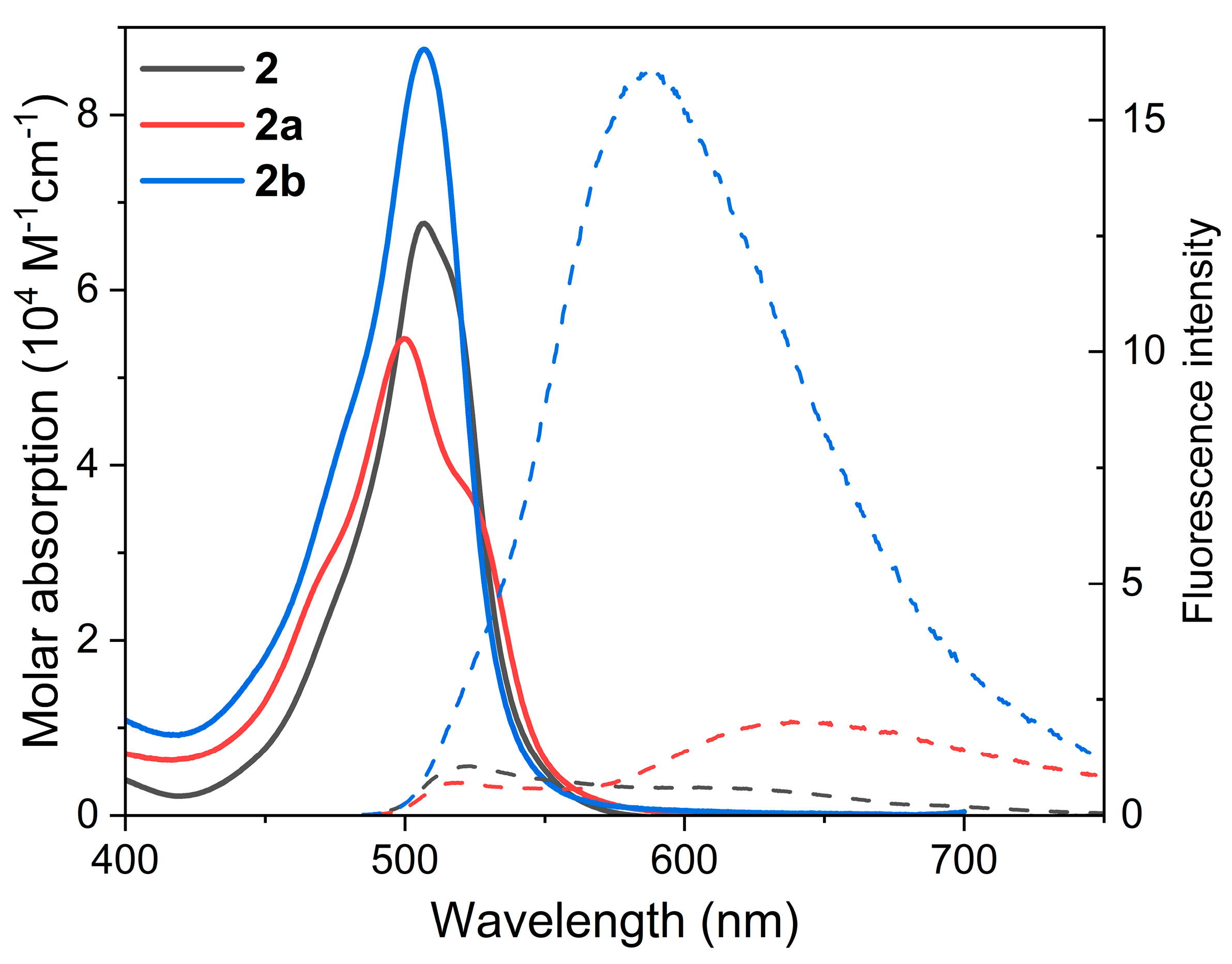
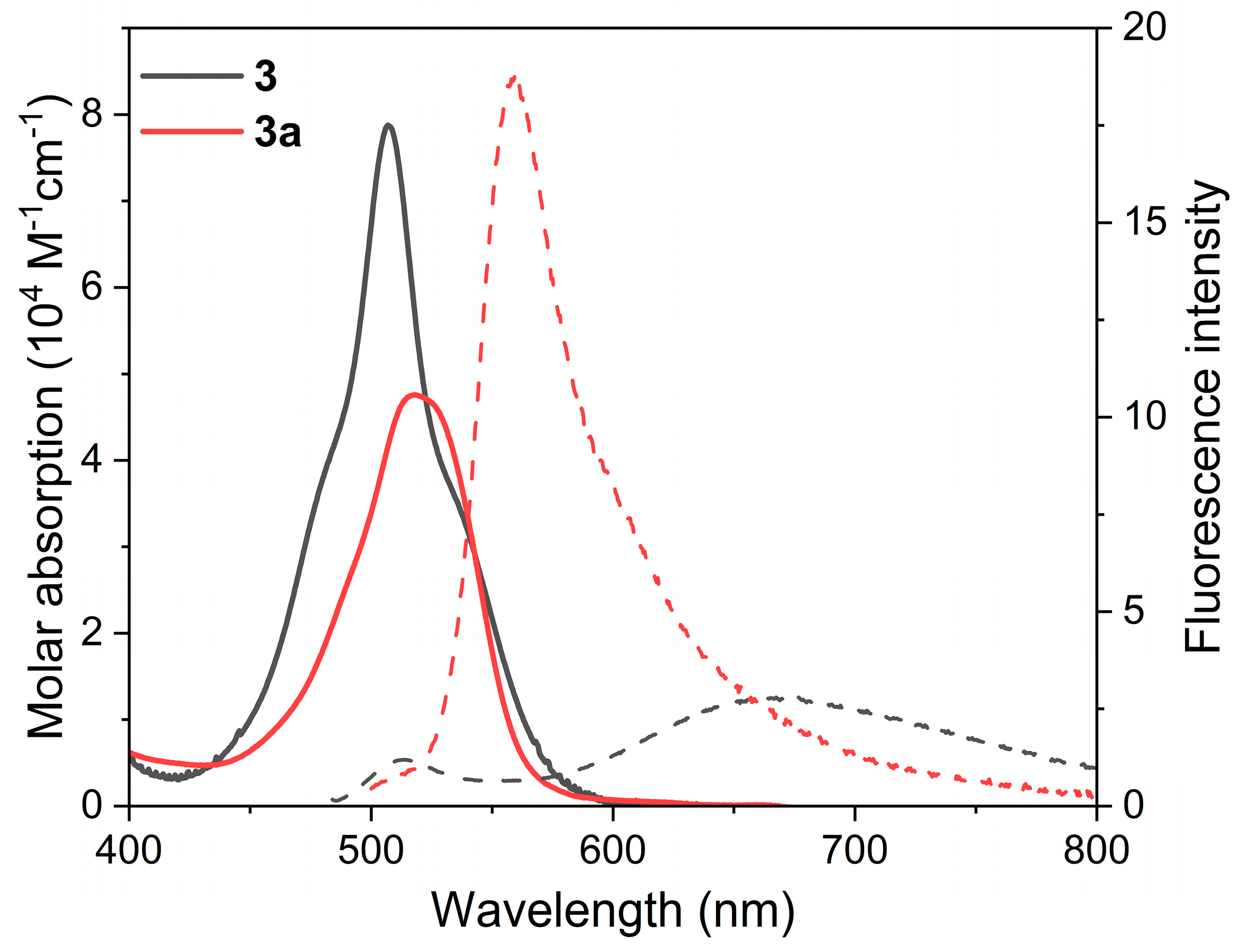


| λab (±0.5 nm) | εmax * (104 M−1 cm−1) | λfl (±0.5 nm) | ϕfl * | τfl * (ns) | ϕΔ* | τT * (μs) | |
|---|---|---|---|---|---|---|---|
| 1 | 511.0 | 16.5 | 525.0 | 0.19 | 0.02 (78%)–5.02 (22%) | 0.84 | 220 |
| 1a | 509.0 | 6.2 | 521.5 | 0.01 | 1.54 (21%)–4.21 (79%) | 0.50 | 165 |
| 1b | 505.5 | 13.9 | 529.5 625.0 | 0.02 | 0.02 (94%)–1.65 (6%) 1.23 (38%)–1.91 (62%) | 0.75 | 215 |
| 2 | 507.0 | 6.7 | 522.5 | 0.01 | 1.59 (25%)–4.84 (75%) | 0.64 | 165 |
| 2a | 499.5 | 5.4 | 519.0 638.0 | 0.02 | 1.85 (21%)–4.87 (79%) 1.18 (92%)–2.62 (8%) | 0.62 | 110 |
| 2b | 507.0 | 8.7 | 587.0 | 0.16 | 2.59 (32%)–4.36 (68%) | 0.50 | 198 |
| 3 | 507.0 | 7.9 | 513.5 676.0 | 0.03 | 2.59 (15%)–4.36 (85%) 1.43 | 0.55 | 110 |
| 3a | 518.0 | 4.8 | 559.5 | 0.19 | 0.50 (14%)–4.06 (86%) | 0.22 | - |
Disclaimer/Publisher’s Note: The statements, opinions and data contained in all publications are solely those of the individual author(s) and contributor(s) and not of MDPI and/or the editor(s). MDPI and/or the editor(s) disclaim responsibility for any injury to people or property resulting from any ideas, methods, instructions or products referred to in the content. |
© 2023 by the authors. Licensee MDPI, Basel, Switzerland. This article is an open access article distributed under the terms and conditions of the Creative Commons Attribution (CC BY) license (https://creativecommons.org/licenses/by/4.0/).
Share and Cite
Díaz-Norambuena, C.; Avellanal-Zaballa, E.; Prieto-Castañeda, A.; Bañuelos, J.; de la Moya, S.; Agarrabeitia, A.R.; Ortiz, M.J. Formylation as a Chemical Tool to Modulate the Performance of Photosensitizers Based on Boron Dipyrromethene Dimers. Int. J. Mol. Sci. 2023, 24, 11837. https://doi.org/10.3390/ijms241411837
Díaz-Norambuena C, Avellanal-Zaballa E, Prieto-Castañeda A, Bañuelos J, de la Moya S, Agarrabeitia AR, Ortiz MJ. Formylation as a Chemical Tool to Modulate the Performance of Photosensitizers Based on Boron Dipyrromethene Dimers. International Journal of Molecular Sciences. 2023; 24(14):11837. https://doi.org/10.3390/ijms241411837
Chicago/Turabian StyleDíaz-Norambuena, Carolina, Edurne Avellanal-Zaballa, Alejandro Prieto-Castañeda, Jorge Bañuelos, Santiago de la Moya, Antonia R. Agarrabeitia, and María J. Ortiz. 2023. "Formylation as a Chemical Tool to Modulate the Performance of Photosensitizers Based on Boron Dipyrromethene Dimers" International Journal of Molecular Sciences 24, no. 14: 11837. https://doi.org/10.3390/ijms241411837
APA StyleDíaz-Norambuena, C., Avellanal-Zaballa, E., Prieto-Castañeda, A., Bañuelos, J., de la Moya, S., Agarrabeitia, A. R., & Ortiz, M. J. (2023). Formylation as a Chemical Tool to Modulate the Performance of Photosensitizers Based on Boron Dipyrromethene Dimers. International Journal of Molecular Sciences, 24(14), 11837. https://doi.org/10.3390/ijms241411837









